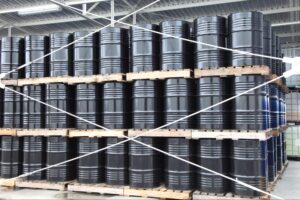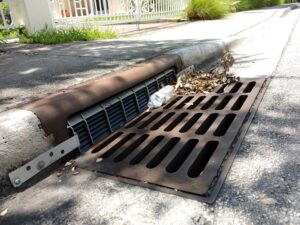Silt Bags: An Effective Solution for Drain Protection

Drain protection is a crucial yet often underestimated aspect of maintaining a well-functioning infrastructure. The sediment-laden water can wreak havoc on your drainage systems, causing blockages, flooding, and environmental damage. But fear not, for there is a secret weapon that is gaining recognition for its remarkable effectiveness: silt bags.
Read on to discover how these unassuming champions are revolutionising drain protection, safeguarding the infrastructure and preserving the environment.


What are Silt Bags?
Silt bags, or sediment control bags, are specialised fabric bags or tubes designed to capture and contain sediments, such as silt, sand, and fine particles while allowing water to flow through. They are commonly used in construction, mining, and environmental applications to control sediment runoff and prevent erosion.
These bags are typically made from a reinforced mesh fabric, which is a durable material with an open structure. As such, it offers excellent strength and filtration properties, allowing water to pass through while effectively trapping sediment. The mesh fabric is selected for its permeability, ensuring that only water can permeate through the bag while retaining sediment particles.
The working principle of silt bags is relatively simple yet highly effective. When deployed in areas prone to sediment runoff, such as around construction sites or along riverbanks, the bags are strategically placed to intercept water flow and capture sediment. As the water passes through the permeable fabric, sediment particles are trapped within the bag while clear water continues to flow downstream.
5 Benefits of Silt Bags
In the realm of sediment control and drain protection, silt bags have emerged as a game-changer. Their remarkable capabilities and effectiveness make them a go-to solution in various industries and environments. Whether it’s construction sites, mining operations, or environmental projects, these bags have proven their worth as an indispensable tool. Let’s take a look into five essential benefits that silt bags bring to the table:
1. Prevents Sediment and Debris Buildup
By serving as a formidable barrier, silt bags effectively capture and contain sediment, silt, sand, and other debris. They act as a reliable shield, intercepting and preventing the accumulation of harmful particles in drains, water bodies, and ecologically sensitive areas.
2. Protects Drainage Systems from Damage
With silt bags in place, drainage systems remain resilient against the hazards of sediment runoff. By trapping sediment before it infiltrates drains, these bags ensure unobstructed water flow, minimising the risk of blockages that could compromise the integrity of the infrastructure.
3. Improves Water Quality
Silt bags play a crucial role in preserving the purity of our water sources. As water passes through the permeable fabric, sediment particles are effectively filtered out, preventing contamination and maintaining optimal water quality. This protection extends to aquatic habitats and ecosystems downstream.
4. Easy to Install and Remove
What makes silt bags even more appealing is their user-friendly nature. They are designed for easy installation and removal, allowing for hassle-free deployment in various settings. Whether it’s for protecting drains, stabilising slopes, or managing sediment around water bodies, silt bags offer a flexible solution that can adapt to diverse applications.
5. Cost-Effective Solution
Silt bags offer a cost-effective alternative for sediment control. Their affordability, reusability, and minimal maintenance requirements make them a smart investment for long-term projects. By reducing the need for expensive cleanup and remediation, silt bags prove to be a financially viable solution.
Importance of Drain Protection
Whether in residential, commercial, or industrial settings, drains play a critical role in facilitating the efficient disposal of water and preventing potential flooding. Maintaining the integrity and functionality of drains is essential to ensure efficient water management and prevent potential hazards.
Several factors can contribute to drain blockage, including the accumulation of debris, sediment, grease, tree roots, or foreign objects. Over time, these materials can obstruct the water flow, leading to reduced drainage capacity and potential backups.
The impact of drain blockage can be far-reaching and detrimental. Blocked drains can result in localised flooding, causing damage to properties and infrastructure. In addition, stagnant water due to blockages becomes a breeding ground for harmful bacteria and microorganisms, posing health risks to both humans and the environment. Moreover, the overflow of wastewater from blocked drains can contaminate water sources, affecting aquatic ecosystems and wildlife.
As such, preventing drain blockage is essential. It ensures the uninterrupted flow of water and prevents flooding, reducing property damage and associated repair costs. By preventing blockages, you can maintain clean and sanitary drainage systems, reducing health risks and promoting a healthier environment. It also minimises the need for disruptive and costly repairs, saving you valuable resources and time.
Silt bags are vital tools for protecting drains from blockages. These specialised bags are designed to capture sediment, debris, and other contaminants while allowing water to pass through. By acting as a filtration system, silt bags effectively trap harmful particles, preventing them from entering and clogging drains. This proactive approach preserves the integrity of drainage systems, maintains water quality, and prevents sediment pollution in surrounding areas.
How to Use Silt Bags for Drain Protection
To harness the full potential of silt bags, it is necessary to understand the proper usage techniques and avoid common pitfalls. By following these few simple steps and steering clear of mistakes, you can optimise the performance of silt bags and keep your drainage systems flowing freely.
Steps to Use Silt Bags
Placement: Identify the areas where drain protection is needed the most. Ensure that the silt bags are strategically placed in front of drains or other water outlets where sediment accumulation is likely to occur.
Secure Installation: Position the silt bags securely, making sure they cover the entire opening of the drain. Use stakes or other fasteners to anchor the bags in place and prevent displacement during heavy rainfall or strong water flow.
Regular Maintenance: Periodically inspect the silt bags for sediment buildup and debris. Remove and replace saturated bags as needed to ensure continuous effectiveness. Dispose of the collected sediment appropriately to prevent environmental contamination.
Tips for Using Silt Bags Effectively
Reusing sediment: Instead of disposing of the sediment trapped in the silt bag, consider reusing it for stabilisation and support purposes in areas where it doesn’t contain pollutants or hazardous materials. This approach promotes sustainability and reduces waste.
Regular inspection: Check the silt bags frequently for clogs or other impairments that may hinder their effectiveness. If any issues are detected, promptly replace the bag to maintain optimal sediment control.
Erosion control: When pumping water away from a construction site, using silt bags can effectively control erosion and prevent the movement of sediment. This practice is environmentally friendly and allows construction activities to proceed without causing harm to existing vegetation or soil.
Common Mistakes to Avoid when Using Silt Bags
While using silt bags is a straightforward process, it is essential to avoid these common mistakes to achieve the best results:
Inadequate Maintenance: Failing to regularly inspect and maintain silt bags can reduce their efficacy over time. Routinely check for sediment accumulation and replace saturated bags promptly to prevent sediment bypass.
Improper Silt Bag Sizing: Using incorrectly sized silt bags can compromise their ability to capture sediment efficiently. Ensure the bags are appropriately sized for the anticipated sediment load and drainage system requirements.
Poor Installation: Inadequate anchoring or improper positioning of silt bags can lead to displacement during heavy rain or water flow, rendering them less effective.
Silt Bags by Ecospill – A Reliable Solution for Effective Drain Protection
The use of silt bags not only improves water quality by filtering out sediment but also contributes to the preservation of surrounding ecosystems by preventing erosion and minimising the disturbance of existing vegetation and soil.
Ecospill’s silt bags are easy to install and remove, providing convenience and efficiency in your drain protection efforts for both short-term and long-term applications. By utilising these versatile tools, you can maintain the integrity of your drains, preserve water quality, and contribute to sustainable water management practices.
Visit our website or contact us to learn more about our reliable stormwater and sediment control products.
